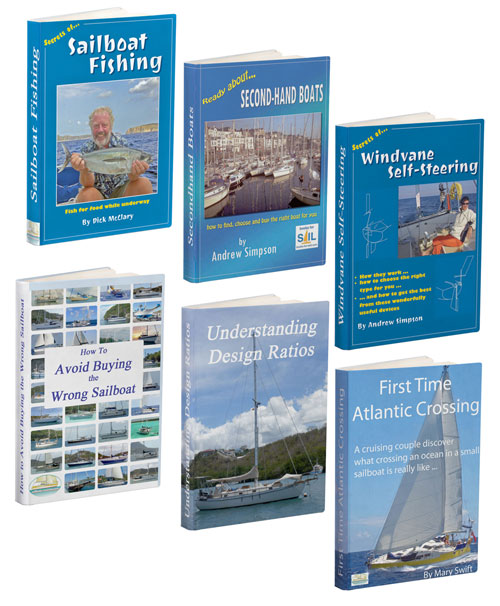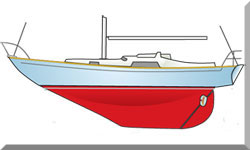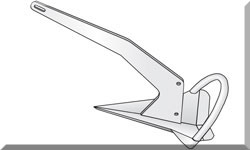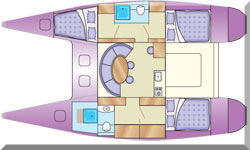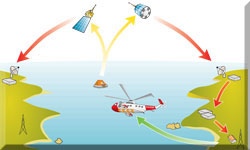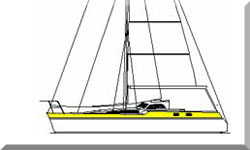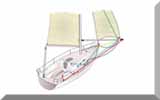- Home
- Bluewater Sailing
- Sailboat Galley Layout
- Gas Boat Cookers
Gas Boat Cookers: A Sailor's Guide to Safe & Practical Galley Systems
In a Nutshell...
Gas boat cookers (or stoves) are the most straightforward solution for the cruising galley, giving you efficiency and worldwide fuel availability. But we have to be honest: using Liquid Petroleum Gas (LPG) means you have to commit to stringent safety standards because of its explosive nature. For any seasoned ocean sailor, a safe system must include a dedicated, vented gas locker, a remote solenoid switch, flame failure devices on every burner, and gimbals ready for all points of sail. Skip the cheap models; robust, corrosion-proof construction and practical kit like secure pan clamps are simply non-negotiable for safety and your peace of mind at sea.
 An ENO cooker with crash bar and hob clamps
An ENO cooker with crash bar and hob clampsTable of Contents
- Cooking at Sea: Why Safety is Paramount
- Gas Supply & Boat Cooker Installation
- Propane vs Butane: Fuel Choice for Offshore Cruising
- Calculating Gas Consumption: Planning for Long Passages
- Essential Features of Quality Gas Boat Cookers
- Market Leaders: A Comparative Overview
- Maintenance & Troubleshooting
- International Compliance & the ISO 10239 Standard
- Summing Up
- Frequently Asked Questions
Cooking at Sea: Why Safety is Paramount
Just think about it: where else would you contemplate handling boiling liquids and hot metal utensils while standing on a rolling, pitching platform?
The marine galley is a uniquely challenging environment, and the risks are substantial. We've all seen the mess—or worse, the danger—when an oven door flies open, a burner is blown out by a gust, or a pan leaps off the hob (that's a 'range' to our American friends). When failures happen, they’re often magnified by poor design or corrosion.
As experienced sailors, we know a system failure—especially involving a pressurised gas system—isn't just a lost meal; it can be catastrophic. That’s why a safe system starts with a robust, well-designed cooker and, most critically, a flawless installation.
Gas Supply & Boat Cooker Installation
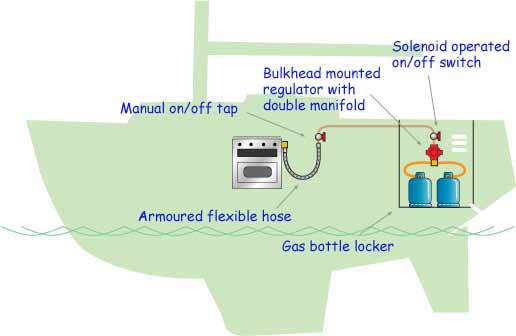 The key components in a gas supply to a cooker
The key components in a gas supply to a cookerLPG (Liquid Petroleum Gas), in either butane or propane form, is easily the most popular fuel for galley cookers. If it weren't for its explosive nature, the choice would be a no-brainer. While other fuels, like paraffin (kerosene) or the less efficient methylated spirits (alcohol), are inherently safer, a properly engineered and installed LPG system will mitigate those safety concerns to acceptable levels.
The core of a safe gas boat cooker installation, as required by best seamanship practice, includes:
- Dedicated Gas Bottle Locker: This is the heart of your safety system. It must be sealed from the rest of the vessel, ventilated to the atmosphere, and critically, drain overboard. The bottles themselves must be firmly secured inside.
- Pressure Regulation: Mount the regulator on a bulkhead inside the locker, not directly on the bottle. Using a double manifold and high-pressure hose allows you to easily switch between two bottles without interrupting the supply line or breaking the seal.
- Remote Solenoid Switch: You need an easily accessible 12v switch to turn the gas supply off remotely. You should flick this off immediately whenever the cooker isn't in use, and certainly in an emergency.
- Leak Detection: Daily checks are vital. A simple bubbler or a sensitive electronic gas alarm should be installed low down in the bilge, as LPG is heavy and will pool there first.
- Manual Turn-Off: A simple tap or valve close to the boat cooker allows for quick isolation at the appliance itself.
Propane vs Butane: Fuel Choice for Offshore Cruising
Most modern gas boat cookers can handle both butane and propane, but if you're serious about long-distance cruising, there's a compelling case for a propane-only set-up.
Propane's major wins are its availability worldwide and, crucially, its willingness to keep working in freezing conditions (it operates down to about -42oC). Butane, in contrast, stops vaporising at -0.5oC, making it useless in colder climes. If you plan on tackling higher latitudes, propane is your only reliable choice.
Of course, while that heat is welcome below decks when it’s freezing outside, the opposite is true in the tropics. There, 'sweating over a hot stove' is more than just a phrase. Make sure your galley has highly efficient ventilation to cope with the heat and moisture.
Calculating Gas Consumption: Planning for Long Passages
Running out of cooking gas is a passage planner's nightmare. Offshore, you can't just make an educated guess; you need to calculate your fuel reserves accurately.
While consumption varies slightly between cooker models, the following figures, based on common European marine appliances, are reliable for planning:
| Burner Function | Approximate Propane Consumption (g/hr) | Hours of Use per 5kg Bottle* |
|---|---|---|
| Large Hob Burner (Full Rate) | 168–220 g/hr | 23–30 hours |
| Oven (Cruising Rate) | 92–100 g/hr | 50–54 hours |
| Grill | 119–128 g/hr | 39–42 hours |
| Total (All on Max) | ~455 g/hr (Neptune 4500 example) | ~11 hours |
Calculating Residence Time: To figure out your endurance, estimate your average daily usage in grams (e.g., how much gas you use for breakfast, dinner, and tea), then divide the total weight of the gas you carry by that daily figure. Do this calculation every time you top up your gas supply.
Essential Features of Quality Gas Boat Cookers
Safety, practicality, and durability—that's the simple recipe for a good boat cooker. You need an appliance that won't fail when you’re wrestling with heavy weather.
Flame Failure Devices
These are thermocouples that only permit gas flow if a minimum temperature is maintained. Consider them your most important safety component—a fire break for your vessel.
They are there for when the flame is accidentally extinguished, perhaps by a rogue gust down the companionway or liquid boiling over. The burner cools quickly, and the gas supply is shut off in seconds. Without this device, the gas would keep flowing, pooling dangerously in the bilge.
Every single burner must have a flame failure device. This isn't the place to chase a budget; a cooker without them has absolutely no business being on a sailboat.
Gimballing
The cooker's ability to swing freely—its gimballing—needs to handle every angle of heel on both tacks.
The cooker's location in the galley is key. Some installations give you unlimited swing on one tack but cause the cooker to crash into its recess on the other, meaning you can't cook when you are hard on the wind. Make sure the installation allows for the maximum heel you anticipate.
Also, be careful of the crash bar. If it sits too close to the cooker, the inboard swing can trap unwary fingers. I know; ours was; it did, twice—until I moved it. Always check that crucial clearance.
The final length of the supply hose must be flexible armoured hose to prevent chafing or pinching when the cooker swings. And, naturally, you should be able to lock the gimbals when you’re alongside or in a bouncy anchorage.
Fiddles and Pan Clamps
A sturdy fiddle rail should always be fitted around the hob. Just as important are the removable pan clamps for each burner. They need to be simple to use but strong enough to hold your pots securely through a nasty swell.
Secure Grill and Oven Doors
The grill pan must be held securely under its burners by a sturdy lip or mechanism. Otherwise, your rashers of bacon and sausages will quickly end up scattered across the galley sole. They’re never quite the same after being trodden on.
For the oven, a lockable door is crucial. I once saw a loaded casserole dish launch itself across the galley—with predictably messy results—when the door catch failed during a particularly violent roll. A proper locking mechanism stops this messy, and frankly dangerous, drama.
Construction Quality and Serviceability
Look for solid, corrosion-proof construction, preferably all stainless steel. The marine environment, with its damp salt air, is merciless. A good cooker should be easy to clean, simple to maintain, and capable of being disassembled and put back together with nothing more than a screwdriver. Quality hinges, catches, and burner parts significantly cut down the chance of failure when you need them most.
Market Leaders: A Comparative Overview
When it comes to offshore reliability, experienced sailors tend to look for specific brand names. Here is a brief comparison of some high-quality marine gas boat cookers you are likely to encounter.
| Brand Focus | Key Differentiating Feature | Construction Material | Typical Price Point |
|---|---|---|---|
| Eno | Excellent balance of cost, quality, and spare parts availability worldwide. Often co-branded with Force 10. | Stainless Steel (often 304L) | Mid-Range |
| Force 10 | Historically known for heavy-duty, robust construction, often favoured for larger offshore yachts. | High-Grade Stainless Steel | High-End |
| Neptune/Tasman (Leisure Products) | UK-manufactured, popular as OEM fitment on many production boats. Good range of spare parts in the UK. | Stainless Steel | Mid-Range |
| Blakes & Taylors | Traditional, non-gimballed paraffin (kerosene) and diesel stoves; a classic choice for high-latitude cruising with non-explosive fuel. | Heavy Brass & Stainless Steel | High-End/Niche |
Maintenance & Troubleshooting
Even the most expensive cooker will let you down without regular care. A proactive maintenance routine is a necessity, not an optional extra, for reliability offshore.
| Maintenance Task | Frequency | Detail |
|---|---|---|
| Gas Leak Check | Daily (when in use) | Use the bubbler or electronic detector. Keep an electronic sniffer handy for finding the source of any small leak. |
| Thermocouple Test | Annually | Check that the flame failure device operates correctly, shutting off the gas within seconds of the flame being extinguished. |
| Burner Cleaning | Monthly (or as needed) | Ensure burner ports are clear of boiled-over debris and salt crystals. A clean, blue flame is what you want. If it’s yellow or orange, you have incomplete combustion or a blockage. |
| Hose & Connection Inspection | Bi-annually | Check all hoses (especially the flexible armoured hose) and connections for cracking, chafing, or corrosion. Replace immediately if you spot any wear. |
| Gimbal Lubrication | Annually | Clean and lightly lubricate the gimbal bearings so they swing smoothly and compensate correctly for boat movement. |
Troubleshooting a Blocked Burner: If a burner is struggling or the flame is weak, it's usually just a blockage. Make sure the gas bottle has enough fuel first. Blockages often occur at the small jet aperture. You can sometimes clear the port carefully with a thin wire, but never try to enlarge the hole with a drill bit.
Winterisation: When laying up the boat for winter, turn off the gas at the bottle, disconnect the regulator, and ideally, store the bottles ashore. In a sealed boat, residual gas and low temperatures can stress rubber seals, creating a future risk. [Note: Always defer to the cooker manufacturer’s specific instructions for lay-up.]
International Compliance & the ISO 10239 Standard
For cruising sailors, safety compliance goes beyond your own vessel; it impacts port inspections and insurance. The accepted international standard for permanently installed LPG systems on small craft (up to 24m) is ISO 10239.
Compliance with this standard (or the relevant national version) is usually a prerequisite for marine insurance and confirms your system meets the essential safety requirements of the EU Recreational Craft Directive (RCD).
Key Compliance Points from ISO 10239:
- Hose Standard: Hoses must comply with ISO 2928 (Rubber hoses for LPG).
- Testing: The standard requires an air tightness test after installation, typically at three times the operating pressure, with zero loss allowed after pressure stabilisation.
- Flame Supervision: All appliances must be equipped with a flame supervision device (FSD).
As a responsible owner, you should ensure your system was installed by a qualified specialist (e.g., Gas Safe Register equivalent) who can provide documentation confirming adherence to the latest ISO standard.
Summing Up
The galley is the heart of any cruising sailboat, and the cooker truly is its engine. Choosing your gas boat cooker is a decision that puts safety and convenience into direct balance. Considering all the specific requirements of the cooker, it's also important to remember that this appliance must integrate perfectly within the wider context of your vessel's catering capabilities. To ensure you have a truly functional and safe working area, you may wish to review the key design considerations when Choosing the Best Sailboat Galley Layout. By adhering to the highest standards of installation—particularly regarding the vented gas locker and remote solenoid—and choosing an appliance with robust construction and full flame failure protection, you are investing directly in the safety and morale of your crew. After a rough passage, there’s nothing that lifts spirits quite like a hot, home-cooked meal, but that comfort must never, ever come at the expense of safety.
This article was written by Dick McClary, RYA Yachtmaster and author of the RYA publications 'Offshore Sailing' and 'Fishing Afloat', member of The Yachting Journalists Association (YJA), and erstwhile member of the Ocean Cruising Club (OCC).
Frequently Asked Questions
1. Is propane or butane safer for use on a boat?
1. Is propane or butane safer for use on a boat?
In terms of inherent explosiveness, they are both highly flammable. The safety difference lies in their operational properties. Both are heavier than air and will sink to the bilge if they leak. Propane operates at a higher pressure, but its superior cold-weather performance makes it more practical for year-round and worldwide cruising.
2. What should I do if I smell gas in the cabin or bilge?
2. What should I do if I smell gas in the cabin or bilge?
Immediate action is critical. Do not switch on or off any electrical appliance. This includes lights, bilge pumps, or the solenoid, as a spark could trigger an explosion. First, manually turn off the supply at the bottle locker. Open all ports, hatches, and the companionway to maximise ventilation. Use the electronic gas detector to pinpoint the source of the leak, and do not use the system again until a professional has certified the repair.
3. Are electric induction hobs a viable alternative to gas cookers for offshore sailing?
3. Are electric induction hobs a viable alternative to gas cookers for offshore sailing?
Electric induction hobs are highly efficient and eliminate the risk of flammable gas, but they are incredibly power-hungry. They are generally only viable for offshore use on larger yachts with substantial battery banks, powerful alternators, and typically, a generator, as they require significant power draw.
4. How often should I replace the rubber gas supply hose?
4. How often should I replace the rubber gas supply hose?
The flexible rubber or high-pressure hose connecting the bottles and running to the cooker should be replaced every five years regardless of its apparent condition. The marine environment quickly degrades materials. Always use certified marine-grade hose and fittings that comply with ISO 2928.
5. Why is a sealed, overboard-draining gas locker so crucial?
5. Why is a sealed, overboard-draining gas locker so crucial?
Because LPG gas is significantly heavier than air, if a leak occurs, the gas will sink and pool in the locker bottom. Since the locker is sealed from the main cabin, this heavy gas cannot enter the vessel but is instead safely vented overboard, preventing a buildup that could lead to an explosion in the bilge.
6. What are the signs of a faulty gas regulator?
6. What are the signs of a faulty gas regulator?
A faulty regulator might show itself as a weak or yellow flame, difficulty lighting burners, or an inability to maintain consistent pressure, even with a full bottle. Regulators are vital safety links and should be replaced immediately or checked by a professional during the annual system test.
Sources Used
- Royal Yachting Association (RYA) Training Materials: Offshore Yachtmaster Curriculum
- ISO 10239: Small craft—Liquefied petroleum gas (LPG) systems (Summary of requirements)
- Marine gas cooker manufacturer specifications (Neptune/Leisure Products, Eno, Force 10)
- The Marine Gas Safety Code of Practice (relevant sections for LPG installations)
- A visual guide to the installation and use of a Force 10 marine cooker: How to use your Force 10 marine cooker
Recent Articles
-
Sailboat Galley Layout: A Guide to Optimising Your Space
Nov 27, 25 05:09 PM
Your sailboat galley layout is crucial for offshore safety and efficiency. Discover expert tips on design, appliances, and ergonomics to make cooking at sea a pleasure. -
Gas Boat Cookers: A Sailor's Guide to Safe Galley Systems
Nov 27, 25 05:05 PM
Mastering safe installation & choosing the best gas boat cookers is vital for offshore sailing. -
Yacht Clearance in the Caribbean: A Sailor's Guide
Nov 25, 25 07:13 AM
Navigating yacht clearance in the Caribbean is essential for a smooth sailing trip. This guide, written by an experienced sailor, explains the required papers, procedures & tips for a hassle-free expe…
